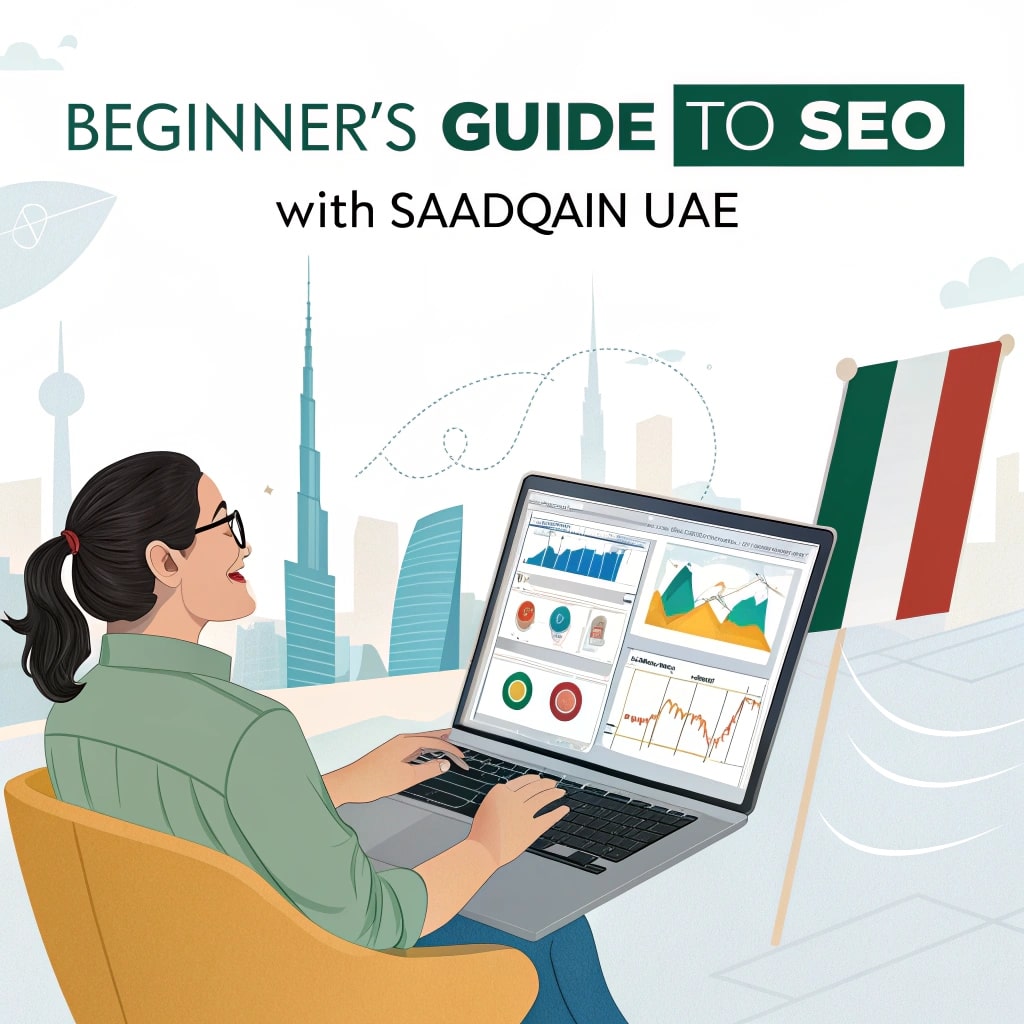Are you pouring effort into your website but not seeing the traffic or customers you deserve?
It’s frustrating, isn’t it? You build a fantastic site, packed with valuable content – yet it feels like shouting into a void. Many get bogged down in complicated technical jargon and expensive tools that don’t deliver.
Imagine attracting the right audience to your website, boosting visibility and driving sales – all without breaking the bank.
That’s exactly what we’ll cover here. This beginner’s guide will reveal the core principles of Search Engine Optimization (SEO) with Saadqain UAE, giving you a solid foundation for success. Let’s get started!
Boosting Websites for Online Success
Does your website feel like it’s fading into the background online? It’s easy to think simply having a site is enough, but that’s where many businesses fall short.
A beautiful design and helpful content aren’t enough if nobody can find you. Search engines are incredibly complex – they don’t just look at pretty pictures; they analyze keywords and relevance.
You might be putting in the effort, but without a solid SEO strategy, your website is essentially invisible to potential customers actively searching for what you offer.
The key isn’t guesswork or fleeting trends; it’s understanding how search engines work and optimizing your site accordingly.
Time spent guessing at keywords is time lost that could be invested in building a sustainable online presence.
Saadqain UAE has built a system to help you do just that – revealing the core principles of SEO that most businesses completely miss.
Let’s dive into exactly what this beginner’s guide covers and how it can transform your website’s visibility.
Keyword Research Basics – Find Gold
Even finding the right words is key when it comes to getting noticed online. Let’s talk about keyword research—it’s like digging for gold!
Think about what people type into search engines when they’re looking for something related to your website. These are called ‘keywords.’
For example, if you sell handmade jewelry, keywords might be “silver earrings,” “bohemian necklaces,” or “unique gemstone rings.” You want to know *exactly* what people are searching for!

Tools can help you find these keywords. There are free ones like Google Keyword Planner and others that offer more in-depth analysis. These tools show you how many other people are searching for a specific term.
If lots of people are searching for “best vegan recipes,” it’s a good keyword to target! But if only a few people search for “purple cauliflower recipe,” it might not be as valuable—at least, not right now.
So, start by brainstorming keywords related to your business and then use tools to see how popular they are. Finding the ‘gold’ – those high-volume, relevant terms – will really help you get found online!
On-Page Optimization – Make it Clickable
While optimizing your website’s pages is crucial for search engines, let’s dive into what “On-Page Optimization” truly means. It’s all about making sure your content is easily understood by both people and computers – essentially, making it clickable!
Think of keywords as the words you want people to use when searching for your site. You need to naturally weave these into your page titles, headings, and throughout the text itself. Don’t stuff them in; aim for a natural flow.
For example, if you sell handmade jewelry, keywords like “unique necklaces,” “artisan earrings,” or “handmade jewelry UAE” are important. Using these terms helps search engines understand what your page is about and shows up when someone searches for those things.
Page titles and meta descriptions also play a huge role. These are the snippets that appear in search results – they’re your first impression! Make them compelling and include relevant keywords to encourage clicks.
A good page title might be “Handmade Jewelry UAE | Unique Designs & Artisan Craftsmanship”. A meta description could say, “Discover stunning handmade jewelry crafted by artisans in the UAE. Shop our unique collection today!”
So, on-page optimization is about strategically using keywords and crafting compelling titles and descriptions to signal to search engines – and potential visitors— that your page offers exactly what they’re looking for. It’s a key step in making sure your website gets noticed!
Content is King – Tell Your Story
It’s like this: “Content is King” isn’t just a catchy phrase; it’s absolutely fundamental to how your website will be seen. You need to think about what you’re offering – not just in terms of products or services, but the *story* behind them.
Consider what makes your business unique. What’s the narrative that draws people in? It could be a fascinating history, a passionate team, or even a commitment to a particular cause. You need to weave this into every piece of content you create – blog posts, product descriptions, social media updates… everything!
For example, if you sell handmade jewelry, don’t just list the materials and prices. Tell the story of where those materials come from, the inspiration behind the designs, and the skill that goes into crafting each piece. That personal connection is what will make your brand stand out.
Think about answering questions potential customers might have. What problems are you solving? How does your product or service improve their lives? Addressing these concerns directly in clear, engaging content establishes trust and demonstrates value.
If you offer a software solution, instead of overwhelming people with technical jargon, explain the benefits in plain language – how it saves them time, boosts productivity, or helps them achieve their goals.
Technical SEO – Behind the Scenes Magic
After Technical SEO – Behind the Scenes Magic is all about making sure search engines can *actually* understand your website. It’s not just about slapping some keywords onto a page; it’s about building a solid foundation that tells Google exactly what your site is about and how to best present it to users searching for related information.
Think of it like this: if you were building a house, you wouldn’t just throw bricks together randomly, would you? You’d need blueprints, foundations, electrical wiring – all the hidden elements that make the structure functional and safe. Technical SEO is doing something similar for your website.
This includes things like ensuring your site loads quickly—slow loading times are a major turn-off for both users *and* search engines. It also means making sure your images have descriptive alt text so Google knows what they’re about.
Another key element is the sitemap. This is a file that lists every page on your website, helping Google crawl and index it efficiently. Without a properly formatted sitemap, Google might miss important pages or take longer to understand your site’s structure.
Essentially, Technical SEO focuses on the ‘under-the-hood’ aspects of your website – things you don’t necessarily see directly—that significantly impact its visibility in search results. It’s about optimizing for *how* Google sees your site, not just *what* words are on it.
Link Building – Grow Your Authority
Think about your website’s authority—it’s like a reputation you build over time. And one of the best ways to strengthen that reputation is through link building. Growing your authority means other websites are recognizing your content as valuable and trustworthy.
Let’s talk about how to get those links – it all starts with creating amazing content that others *want* to share and back up.
If you’re writing a killer guide on “The Best Coffee in Dubai,” other blogs and websites will naturally want to link to it because it’s helpful information for their readers too! The more valuable your content, the more likely others are to link to it. It’s like offering something people can’t refuse—a great resource.
Now, let’s get specific about how you can actively seek out those links – what’s called “link building.”
One simple approach is outreach. Find websites in your niche and politely ask if they’d consider linking to your content. It’s not about begging; it’s about showing them the value of your work. Another way is guest posting—contributing articles to other sites with a link back to yours.
Essentially, building links is about demonstrating that your website offers something truly valuable and worth sharing – which ultimately boosts its authority and helps you grow in search results.
Understanding Google’s Algorithm – Stay Ahead
People often think of Google’s algorithm as some mysterious black box. But really, it’s all about understanding what Google wants to see in a website. It’s like you are trying to please your parents – you want to do things that make them happy!
Google’s primary goal is to provide the most relevant and helpful results for searches. When someone types something into Google, the algorithm analyzes *everything* it can find on the web.
It looks at keywords – what words are being searched for? It examines website content – does it actually answer the question? And it checks things like backlinks – how many other websites link to yours? The more relevant your site is, the higher it’ll rank!
Staying ahead means you need to know that Google constantly updates its algorithm. These changes happen regularly and they can significantly impact a website’s ranking.
Think of it like this: if you suddenly started focusing on a different set of criteria, everything would shift around. So, you have to stay informed about these updates so that you can adapt your strategy!
Understanding how Google’s algorithm works is the first step in improving your website’s visibility and attracting more visitors. It’s not magic – it’s just smart optimization based on what Google values most.
Mobile Optimization – Reach Everyone’s Screens
Through optimizing for mobile screens, you can reach a much wider audience. It’s more than just making your website look good on a phone—it’s about ensuring it *works* well.
Think about the sheer number of people who browse the internet primarily through their smartphones or tablets. If your site isn’t designed for those devices, you’re missing out on a huge chunk of potential visitors.
Mobile-first design means prioritizing how your content looks and functions on smaller screens. This often involves using larger fonts, simplified navigation, and ensuring images load quickly—all things that can slow down a desktop website.
You need to consider responsive design – this adapts automatically to the screen size it’s viewed on. It’s like magic!
Responsive websites make sure everything looks fantastic whether someone is viewing your site on a tiny smartphone or a large desktop monitor. This ensures a smooth experience for everyone, no matter how they choose to access your content.
So, focusing on mobile optimization – reaching everyone’s screens – isn’t just about being trendy; it’s about making sure you’re accessible and providing the best possible experience for every visitor.
Website Speed – Seriously Fast Loading
Imagine your website loading in a blink. It’s not just nice; it’s absolutely crucial for success online.
Seriously fast loading times are essential to keeping visitors happy and engaged with your site. When pages take too long to load, people will simply bounce away – meaning they leave without looking at anything else on your website!
Google also takes page speed into account when ranking websites in search results. So, a faster loading site is more likely to show up higher in the search results and attract more organic traffic—that’s free traffic from people searching for what you offer.
You can optimize your website’s speed by focusing on several key areas. One of the biggest factors is image size – large images take ages to load!
Compressing those images so they are smaller, without sacrificing quality, makes a huge difference. There’s plenty of free online tools that can help you do this—it’s much easier than you might think.
Ultimately, seriously fast loading times create a better user experience, improve your search engine rankings and boost your website’s overall success.
Local SEO – Connect with Your Community
The first step in connecting with your community through local SEO is understanding where they’re searching.
You need to make sure your website shows up when people nearby are looking for what you offer. This means focusing on keywords that relate specifically to your location and business type.
For example, if you own a bakery in Dubai, ‘best cupcakes Dubai’ or ‘cake shop near me’ are the kinds of phrases someone might use when searching online. Using these terms helps Google understand what you do and where you’re located.
Claiming and optimizing your Google My Business profile is essential— it’s like putting up a digital sign for your business!
Make sure all the details are correct: address, phone number, website link, hours of operation. Also, add high-quality photos of your products or services. This helps potential customers get a better sense of what you offer and encourages them to visit.
Essentially, local SEO is about making sure people searching for businesses like yours in your community can easily find you online— building that connection within your neighborhood.
Analyzing & Tracking – See What Works
Yes, understanding where your website stands is key to boosting its performance. Analyzing what’s working—and what isn’t—is absolutely crucial for success with SEO.
You need tools that will show you exactly how people are finding your site. Think of it like a detective investigating a case – gathering clues!
Google Analytics is a fantastic starting point. It tracks things like where visitors come from (search engines, social media?), which pages they visit most, and how long they stay. This data helps you see what’s capturing attention.

Don’t just look at the numbers; dig deeper! Analyzing your keyword rankings is vital – are you showing up for the terms you *want* to rank for?
Tools like SEMrush or Ahrefs can help you track your position in search results for specific keywords. Seeing a drop in ranking means it’s time to adjust your strategy.
Essentially, consistently tracking and analyzing this data will let you make informed decisions about your SEO efforts – ultimately helping you see what works best and maximizing your website’s potential.
Saadqain UAE’s Approach – A Strategic View
Just a strategic view from Saadqain UAE is about understanding that your website isn’t just *there*. It’s a key part of how you connect with people.
It starts by recognizing what matters most to your business – what are you trying to achieve? What do you want customers to find when they visit your site?
Are you selling products? Then it’s about making those products easy to see and buy. Are you offering information? It’s about organizing that information clearly so people can quickly find what they need.
Saadqain UAE focuses on building a plan – a roadmap – for your website. This isn’t just random guesses; it’s based on careful research and understanding of how search engines like Google work.
They look at keywords – the words people actually type into search engines when looking for what you offer. They analyze your competition to see what they’re doing well (and where they might be falling short).
Essentially, Saadqain UAE’s approach is about taking a smart, targeted strategy and building a website that truly gets found by the people who are most likely to become your customers.
Ongoing Optimization – Continuous Growth Strategies
During ongoing optimization— continuous growth strategies, it’s about constantly refining your website’s approach. It isn’t a one-time fix; it’s a consistent process that keeps you ahead of the curve.
Think of SEO like tending a garden—you need to regularly prune, fertilize, and adjust to ensure everything thrives.
This means consistently monitoring your website’s performance through tools like Google Analytics. What keywords are driving traffic? Which pages are performing best (and worst)? This data reveals what’s working and where you can improve.
It also involves staying informed about algorithm updates from search engines. These changes directly impact how websites rank, so you need to adapt your strategy accordingly.
For example, a recent update might prioritize mobile-first indexing—meaning the mobile version of your site is now more important than ever. You’d want to make sure your website is fully optimized for mobile users!
So, ongoing optimization— continuous growth strategies means embracing a mindset of constant learning and adjustment. It’s about proactively shaping your website’s future rather than simply reacting to changes.
Turning Browsers into Buyers: Making Your Website Shine Online
A website brimming with potential doesn’t automatically translate to customers knocking at your door.
Many businesses underestimate the power of Search Engine Optimization, or SEO. It’s about making sure people can actually *find* your amazing site when they’re searching for what you offer. Without a solid SEO strategy, your website might be hidden amongst millions of others – essentially invisible to those actively looking for solutions like yours. It’s not just about keywords; it’s about crafting content that resonates with search engines and users alike, building authority, and ensuring your site is technically sound for optimal crawling and indexing.
The sooner you start implementing basic SEO techniques – things like optimizing page titles, using relevant keywords naturally within your content, and building high-quality backlinks – the faster your website will rise in search engine rankings. This increased visibility directly translates to more organic traffic, qualified leads, and ultimately, boosted sales or conversions.
Don’t let your brilliant website languish unseen. Begin today to refine your online presence; invest the time to understand these foundational strategies, and watch as your brand gains momentum and achieves its full potential.

